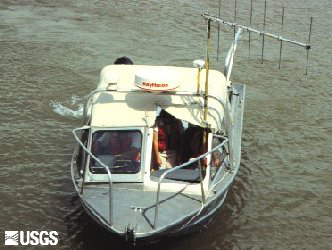- Home
- About S&T
- Taxa/Organisms
- Ecosystems
- Issues
- Methods & Tools
- Reports & Publications
- Location
- Search
2002 | Publisher: USGS | Science Center: Western Fisheries Research Center (WFRC, Seattle) | Format: URL
wfrc.usgs.gov — The value of this long-term monitoring program will provide data crucial for understanding demographic and reproductive characteristics of these endangered sucker populations. This research will have wide applicability to federal, state, and tribal agencies in the basin for management and recovery efforts.

June 2001 | Publisher: USGS | Science Center: Upper Midwest Environmental Sciences Center (UMESC, LaCrosse) | Format: URL
www.umesc.usgs.gov — This report describes an electronic database containing 474 annotated citations that are relevant to fish passage through dams in large temperate floodplain rivers. The goal of this project was to survey the literature to help define the potential ecological consequences of restricted fish passage through dams in the Upper Mississippi River System More...

September 10 2000 | Publisher: Other (Grand Canyon Monitoring and Research Center) | Format: .PDF
www.gcmrc.gov — Lees Ferry was stocked with Rainbow Trout in the early 1960`s. Since then, it has been a nationally acclaimed and world renowned blue ribbon fishery. With its value as a recreational play land for fishermen and safe haven for wildlife, the function and impact of the Glen Canyon Dam has become increasingly important for study and monitoring.

Publisher: USGS | Science Center: Western Fisheries Research Center (WFRC, Seattle) | Format: URL
wfrc.usgs.gov — Viral infections are common causes of disease outbreaks and mortalities in both wild and captive fish populations. Due to the long history of virus outbreaks there is a substantial body of knowledge about viruses within the field of fish pathology. This project involves research and development studies which create, modify and apply modern More...

Publisher: USGS | Science Center: Western Fisheries Research Center (WFRC, Seattle) | Format: URL
wfrc.usgs.gov — Anadromous salmonids are susceptible to a variety of pathogenic microorganisms, including at least 30 bacteria and viruses. Whereas the impact of these microorganisms on salmonids in wild and natural rearing areas is difficult to measure, losses from disease among hatchery salmonids are both common and well documented. The immunology laboratory More...

Publisher: USGS | Science Center: Western Fisheries Research Center (WFRC, Seattle) | Format: URL
wfrc.usgs.gov — Salmonid species in the Pacific Northwest continue to decline despite management efforts to mitigate the effects of development of the Columbia River basin and power system. Altered fish species diversity and changes in the aquatic habitat have created the need for research to determine the status, life history, and habitat requirements of at risk More...

Publisher: USGS | Science Center: Western Fisheries Research Center (WFRC, Seattle) | Format: URL
wfrc.usgs.gov — This U.S./Russian collaboration will investigate genetics and life histories of Kamchatka Peninsula rainbow trout and steelhead (O. mykiss), and Dolly Varden, white-spotted, and arctic char (S. malma, S. leucomaensis, and S. alpinus, respectively). Both anadromous and resident forms of these generally occur in Kamchatka rivers that are free from More...

Publisher: USGS | Science Center: Western Fisheries Research Center (WFRC, Seattle) | Format: URL
wfrc.usgs.gov — Ballast water discharges are the most significant cause of aquatic biological invasions in coastal waters, including the Great Lakes. Currently, treatment of ballast water prior to discharge at the receiving port offers significant promise to help control this problem. However, development of treatment technologies is limited by lack of objective More...

Publisher: USGS | Science Center: Western Fisheries Research Center (WFRC, Seattle) | Format: URL
wfrc.usgs.gov — This project addresses the occurrence of metal and organochlorine contaminant residues in commercial feeds purchased by the U.S. Fish and Wildlife Service (FWS) hatcheries. Research into fish feed quality could benefit all hatchery and aquaculture operations and assist in the interpretation of the effects of pollution on wild fish. Results from More...

Publisher: USGS | Science Center: Western Fisheries Research Center (WFRC, Seattle) | Format: URL
wfrc.usgs.gov — This study evaluates costs and benefits for alternative sources of broodstock for supplementation, and tests for domestication in hatchery programs. The study tests for genetic differences in the migration, growth, and survival of hatchery and wild steelhead (Oncorhynchus mykiss) and of hatchery and wild spring chinook salmon (O. tshawytscha) in More...

Publisher: USGS | Science Center: Western Fisheries Research Center (WFRC, Seattle) | Format: URL
wfrc.usgs.gov — Research biologists at the Columbia River Research Laboratory are using global positioning systems (GPS) in a study of the distribution of juvenile salmon in relation to dissolved gas supersaturation in the Columbia and Snake rivers. The study is being conducted between Ice Harbor Dam on the Snake River and on the Columbia River, a distance of 42 More...

Publisher: USGS | Science Center: Western Fisheries Research Center (WFRC, Seattle) | Format: URL
wfrc.usgs.gov — This is a research summary who's project objectives are to: 1) Coordinate watershed stakeholders in order to guide the implementation of watershed restoration actions that are consistent with stakeholder objectives, 2) Monitor physical habitat conditions and natural production of juvenile, smolt, and adult steelhead in the Wind River sub-basin, More...
